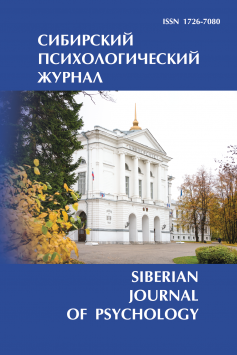Interactions of the CNS functional characteristics and cognitive processes in children with neurotic disorders of a residual-organic origin
The article considers relation features between CNS functional characteristics, cognitive processes, and age of children with borderline mental disorder of residual-organic genesis. For this purpose, parameters of attention, memory, mentation, and reaction are studied. The parameters are subjected to correlation analysis. On the base of the results obtained, conclusions about the peculiarities of cognitive processes and possibilities of their compensation in these children are made. These findings relate to both the general aspects common to all children with neurotic disorders residual-organic origin, and to particular aspects related to patients with certain nosological specificity. In the article it is shown that correlation bonds reflect the integration of different level cognitive processes. For the cognitive task requiring urgent restructuring of the reaction, it is needed a common activation provided by the pyra-mid-striatal level of the organization, including the pyramidal (cortical) and extrapyramidal (subcortical) control, whereas for the implementation of cognitive processes the activation of the cerebral cortex is primarily essencial. It is also shown that all children with borderline mental disorders are characterized by disintegration of attention processes. It is suggested that children with asthenic disorders [F 06.06] and children characterized by involuntary action and the lack of cerebral control formation of excretory functions [F 98.0; F 98.1; F 98.3] differ by insufficient formation of spatio-temporal representations. Children with asthenic disorders [F 06.06] and behavior disorders [F 98.8; F 98.9] are characterized by improving with age the CNS functional performance and characteristics of cognitive processes. It does not occur with children having underdeveloped cerebral control over excretion and movement functions [F 98.0; F 98.1; F 98.3], which may lead to mental retardation. It was found that in these children correlations between the CNS functional characteristics and the cognitive process parameters are virtually absent. This indicates a discrepancy between the level of CNS functional abilities and the level of the cognitive process development. Based on the results obtained the recommendations for psychological work with children with borderline mental disorders of residual-organic genesis are formed. So, working with children with asthenic disorders [F 06,06] and disorders of behavior [F 98.8; F 98.9] is recommended to direct to the development of certain cognitive functions. In the first case they are: memory, attention, spatial, and temporal representations; in the second case they are: memory, attention, and assimilation of verbal experience. The work with children with insufficient formation of cerebral control over the excretion and movement functions [F 98.0; F 98.1; F 98.3] should be directed at correction of their development in general.
Keywords
неврозоподобные расстройства резидуально-органического генеза, время реакции, функциональные показатели ЦНС, память, внимание, мышление, познавательные процессы, корреляционный анализ, borderline mental disorder, residual-organic genesis, reaction time, CNS functional characteristics, memory, cognition, cognitive processes, correlation analysisAuthors
| Name | Organization | |
| Berezkin Dmitry V. | Child sanatorium «Komarovo»; The Herzen State Pedagogical University of Russia | berezkin.dm@yandex.ru |
References
Interactions of the CNS functional characteristics and cognitive processes in children with neurotic disorders of a residual-organic origin | Sibirskiy Psikhologicheskiy Zhurnal – Siberian Journal of Psychology. 2016. № 62. DOI: 10.17223/17267080/62/11
